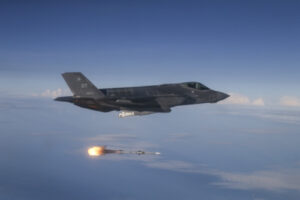Defense Daily International
-
DDI for Fri. March 16, 2018
- Report Suggests Multiple Approaches To Better Integrate Allied Defense Industrial Base
- Qatar Purchases 28 NH90 Multi-Role Helicopters, 16 H125 Training Helicopters For $3.7 Billion
- Lockheed Delivers First TPS-77 MRR To Latvia
- Mississippi Welcomes Israeli Cooperation On Border Protection, Gov OK With Tariffs
- Trump Administration Says Russia Hacking U.S. Energy Grid; Levies New Sanctions
- Kratos Receives Approval To Market Its Mako UAS Abroad
- HASC Leadership Urges President To Fully Fund Counter-Information Warfare Office
-
 Uncategorized
UncategorizedReport Suggests Multiple Approaches To Better Integrate Allied Defense Industrial Base
New exemptions for controlled goods, program licensing, integration of performance based logistics contracting, and improving standards to better enable open systems architecture among international partners are among the key recommendations […]
-
 Uncategorized
UncategorizedLockheed Delivers First TPS-77 MRR To Latvia
Lockheed Martin [LMT] successfully completed a site acceptance test for its new TPS-77 Multi-Role Radar (MRR) in Latvia while delivering the first of three of transportable radars for the country’s air […]
-
 Uncategorized
UncategorizedQatar Purchases 28 NH90 Multi-Role Helicopters, 16 H125 Training Helicopters For $3.7 Billion
Qatar has agreed to a new $3.7 billion contract to purchase 28 NH90 multi-role helicopters for its military and 16 H125 light single-engine helicopters for training with its Armed Forces […]
-
 Uncategorized
UncategorizedKratos Receives Approval To Market Its Mako UAS Abroad
Kratos Defense & Security Solutions [KTOS] has received approval from the State Department to market its Mako High Performance Jet Tactical Unmanned Aerial System (UAS) to select countries in Europe and […]
-
 Uncategorized
UncategorizedHASC Leadership Urges President To Fully Fund Counter-Information Warfare Office
A bipartisan group of lawmakers sent a letter to the president on March 15 urging him to fully resource and staff the agency tasked with countering foreign disinformation campaigns, including […]
-
 Uncategorized
UncategorizedMississippi Welcomes Israeli Cooperation On Border Protection, Gov OK With Tariffs
The governor of Mississippi welcomed increased cooperation between U.S. and Israeli homeland security and defense companies on March 13. “I believe what we can learn from the real world experience, […]
-
 Uncategorized
UncategorizedTrump Administration Says Russia Hacking U.S. Energy Grid; Levies New Sanctions
The Russian government is behind an ongoing and deliberate cyber hacking campaign against the energy sector in the U.S. but so far attempts to access critical network systems have failed, […]
-
DDI for Fri. March 9, 2018
- State Department Approves Possible $270.4 Million Deal with UAE For Sidewinder Block II Missiles
- DARPA Pushing Hypersonic Missile Development To Meet Russia, China Capabilities
- State Approves Possible $197 Million Deal To Upgrade Qatar’s Air Force Operations Center
- AeroVironment Receives $44.5 Million Puma AE UAS Deal From Country In Middle East
- State Department Approves Possible $45 Million Deal With Japan For Phalanx CIWS Conversion Kits
-
 Uncategorized
UncategorizedDARPA Pushing Hypersonic Missile Development To Meet Russia, China Capabilities
The head of the Defense Advanced Research Project Agency (DARPA) is looking to speed up the development of hypersonic missile capabilities to meet those of Russia and China, including seeking […]
